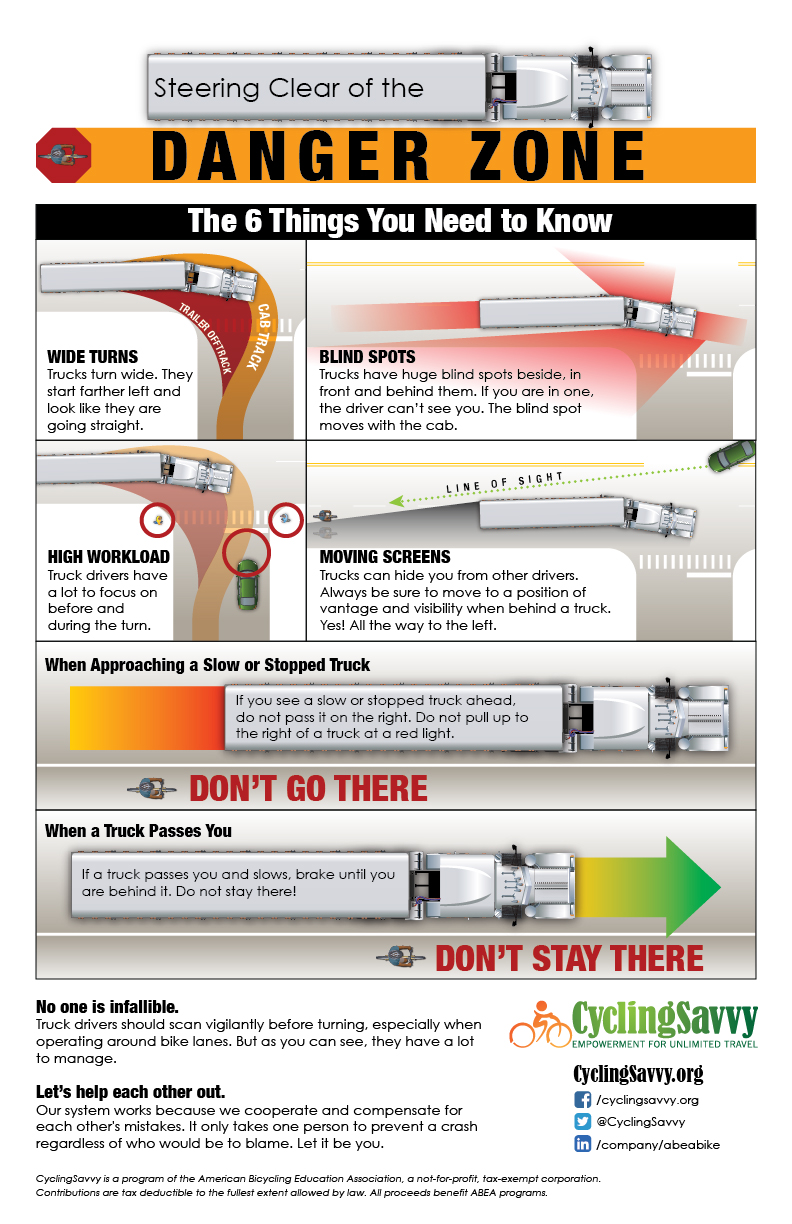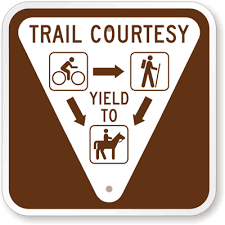Knowledge That Could Save Your Life
This post wraps up our series on lane position, which started with Four Reasons to Avoid the Edge of the Road, and continued last week with Lane Position Choices. This week, we'll take a look at two of the most dangerous situations that unwary cyclists can find themselves in.
Spoiler alert: Both of them can be avoided by taking a position away from the edge of the road.
1. How to Avoid the Right Hook
This is when a cyclist hits, or is hit by, a right-turning car. This can happen in two ways. |
| Car passes cyclist, then turns right |
 |
| Cyclist passes stopped cars on their right |
Both of these can happen with or without a bike lane. And as with all intersection crashes, a bike lane does not protect you here. In too many cases, bicyclists may feel safe because they're in a bike lane, and ride right up into a motorist's blind spot. The problem is made worse when the bike lane has been physically separated from the travel lane, such as by bollards or parked cars. The separation creates a sight obstruction.
A bike lane that goes right up to the corner actually encourages behavior that is exactly counter to bicycle education's recommendation of taking your place in line at red lights. This is a problem inherent to all edge bike lanes (except those with a separate green light for bikes, which are rare and not even possible at most intersections). Additional treatments like green paint are only attempts to mitigate the problem created by the bike lane in the first place!
 |
| Does this lane configuration make sense? |
 |
| Then why would this? |
As we mentioned in the Four Reasons post, this is an excellent reason for cyclists not to ride up on the right of stopped traffic, regardless of what many cyclists do, and even with a bike lane. It bears repeating from last week, "don't let the paint think for you"! Be wary of cars passing you and turning right at any intersection, and in the case of stopped traffic, just get in line!
Right Hooks with Trucks
Although any right hook can be fatal, there is one variation that is especially dangerous: trucks.Never ever pass a stopped truck on the right!!
This poster from CyclingSavvy is a better summary than I could possibly write. You can download a printable PDF copy from this page, which also includes a video (part of CyclingSavvy's free Essentials short course) and interactive graphics.
2. How to Not Get "Doored"
Getting hit by the opening door of a parked car is unfortunately so common that cyclists have a nickname for it: getting "doored". Many veteran urban cyclists have experienced this. A 2018 study of doorings in 10 North American cities (and one in Australia) found that they accounted for between 12 and 27 percent of urban car/bike collisions. The following map shows locations of 577(!) dooring crashes over a 3-year period in Chicago.I keep a non-scientific and surely incomplete spreadsheet of fatal doorings that I hear about around the world. I have heard of 2 so far in 2020, in San Francisco, and Toulouse, France. Brooklyn, NY alone had 3 of them in 2019, the first on New Year's Day. Consider that again: Three bicyclists in one year were killed by opening car doors in Brooklyn, NY!
Some cyclists try to give helpful advice like "look through the back window for drivers" or "be prepared to swerve suddenly". This advice is useless. Many cars have headrests or tinted windows that prevent you from seeing the driver. As for swerving suddenly, are you really going to have time to look behind you first to make sure no one's about to pass you?
Safety experts define the average human reaction time as 2.5 seconds. A cyclist going at a modest 10 MPH (15 feet/second) will cover about 36 feet in that time. That's several car lengths. Conclusion: If the door opens within 3 car lengths of the cyclist, there is not enough time to react. It happens that quickly.
You know who else has insufficient time to react? The passing motorist whose car the cyclist swerves or is thrown in front of. Most dooring fatalities are the result not of hitting the door itself, but of the cyclist subsequently getting run over by passing traffic, either because they swerved involuntarily, or because the door knocked them into the travel lane. This video includes some disturbing real life footage of doorings (set to music with a well-known Rolling Stones song).
There is really only one way to avoid being hit by a car door: don't be there. Ride at least 5 feet away from a parked car! Motorists don't drive that close to parked cars, why should cyclists be expected to?
Once you've gotten at least 5 feet away, then consider other factors such as how wide the travel lane is, whether you're still likely to get squeeze-passed, and what your vantage around the parked cars is like. You may want to ride even farther left to guard against those risks!
Here's a picture I introduced in my Four Reasons to Avoid the Edge post a few weeks back. In that post, I mentioned that the main reason for being in the middle of the lane there was vantage to motorists pulling out of the liquor store. The parked cars contribute to the need to be away from the edge, out of the reach of their doors. Like most towns, Main Street in Westbrook has frequent parallel parking zones.
 |
Bike Lanes and Parking
Unfortunately, some traffic engineers design bike lanes to be right in the "door zone", such as this one. (And some bicycle advocates say they are "better than nothing", a sentiment with which many of us vehemently disagree.) |
| A "door zone bike lane" (DZBL) |
Engineers are getting better about including buffer zones between a bike lane and parking lane, but there are still far too many bike lanes without one. As we keep saying, "Don't let the paint think for you". If a bike lane is in the door zone, do not use it. You are under no legal obligation to use a bike lane that puts you in danger.
Other Dangers from Parked Cars
Getting doored is not the only danger presented by parked cars. Here is a list of other problems that I have successfully avoided over the years by riding outside the door zone:- Cars pulling out of a parallel parking space
- Cars pulling or backing out of driveways near parked cars
- Pedestrians walking into the street between parked cars
- A wrong-way bicyclist coming right towards me from around the front of the parked car I was passing
- A driver sitting in his parked car who extended his arm out the open window, with a lit cigarette at the end of it!
Advice to Motorists
It is illegal in all states to open your door without first checking to make sure it is safe. (Maine statute) Since many bicyclists unfortunately ride too close to parked cars, it is imperative that you check for bicyclists before you open your door! Look in your side mirror for at least several seconds, and also turn your head to check your blind spot. Some people say if you reach around to open the door with your right hand, it makes it easier to turn your head. But that may still not be as effective as looking in your side mirror for several seconds.
Respect for ourselves and each other helps keep everyone safe!
Have fun and ride safe!





Comments
Post a Comment